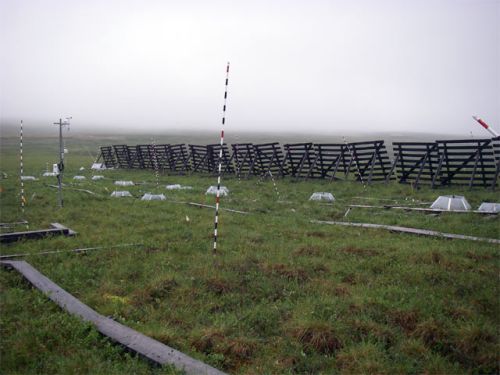Polar Date: July 20 & 21, 2008
The weather did not give us a break for long. Sunday and Monday were both gray, rainy, foggy and cold. I spent Sunday working on my lessons and activities that I will be having my students do in the fall. A major part of PolarTrec is for the PolarTrec teachers to take their field experiences and translate them into meaningful labs and experiments. It’s a challenge because the researchers here use very high-tech and expensive equipment that is not available to classrooms or schools. Additionally, the science is extremely complex, and it’s necessary to make the activities understandable while still providing an opportunity for them to have valid results.
Since this is my last week at Toolik, I want to begin writing more specifically about permafrost ecology and why it’s important to understand what’s happening with the permafrost throughout the Arctic regions.

There are many national and international organizations that work together on circumpolar Arctic research. Toolik Lake is a field station that hosts many of these organizations.
1. Long Term Ecological Research (LTER). http://www.lternet.edu/ Has more than 1800 scientists and was established by the NSF in 1980. There are 26 LTER sites around the United States, including Toolik. To see where the other LTER sites are located, check out the resource links below.
2. International TundraA treeless area between the icecap and the tree line of arctic regions, having a permanently frozen subsoil and supporting low-growing vegetation such as lichens, mosses, and stunted shrubs. Experiment (ITEX) http://www.geog.ubc.ca/itex/about.php From their website: *"The International TundraA treeless area between the icecap and the tree line of arctic regions, having a permanently frozen subsoil and supporting low-growing vegetation such as lichens, mosses, and stunted shrubs. Experiment is a collaborative effort involving scientists from more than 11 countries, including all the Arctic nations. ITEX seeks to examine the response of circumpolar cold adapted plant species to environmental change, specifically to an increase in summer temperature. Empirical knowledge based on experiments coupled with available evolutionary history, ecology, and genetics was chosen as the best way to predict species response to climate change.” * For a real geography challenge, try looking up these ITEX sites: Alexandra Fiord,Atqasuk,Audkuluheidi, Baker Lake, Barrow, Bylot Island, Churchill, Daring Lake, Disko Island, Finse, Furka, Haibei, Hot Weather Creek, Hveravellir, Igloolik, Iqaluit, Kilpisjarvi, Latnjajaure,Lower Kolyma, Macquarie Island, McMurdo Dry Valleys, Meks, Mt. Dionisiy, Mt. Fuji, Mt. Kisokomagadake, Mt. Skalafell, Mt Tateyama,, Niwot Ridge, Ny-Alesund, Obergurgi, Petropavlovsk, Ragozhniy Peninsula, Rotmoosferner, Schrankogel, Sornfelli, Sverdrup Pass, Syowa Station, Taimyr, Taisesu Mountains, Tanquary Ford, Thingvellier, Toolik Lake, Truelove Lowland, Val Bercla, Val d’Arpette, Wolf Creek, Yamal, Zackenberg and Ziegler Island.
Here’s a picture of some of the Itex plots here at Toolik Lake.

The open plastic cone-shaped collars are designed to increase the temperature of the tundra under the plastic, while still allowing light and precipitation to get through to the plants and ground beneath. If you visit the ITEX website, you can see pictures of sites that look just like the Toolik sites, since the experiment is being replicated on tundra all over the Arctic region.
I’ll finish this up in the next installment, after I tell you about Sunday's dinner, where we were treated to a complete Thanksgiving dinner - turkey, stuffing, mashed potatoes & gravy, green bean casserole, rolls & butter, salad with pumpkin cake for dessert. Happy Thanksgiving!
Signing off from Toolik Lake, and remember, *"There are no passengers on Spaceship Earth. We are all crew”. ~Marshall McLuhan, 1964 *
| Attachment | Size |
|---|---|
| LTER sites.pdf341.29 KB | 341.29 KB |


Comments